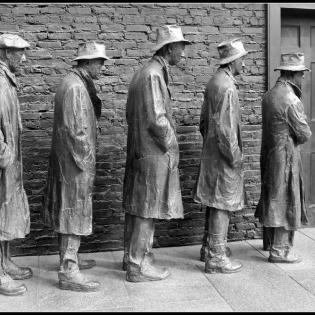Life During the Depression: Images and Interviews
Using primary source images and interviews, participants learn about life and economics during the Great Depression and how different sectors of society contributed to bringing the country out of this dark period.
The learner will:
- interpret primary sources from The Great Depression.
- hypothesize about possible solutions that could have relieved suffering during the Great Depression.
- analyze motivations for giving during The Great Depression.
- Images of the Great Depression - Link to Google Slideshow
- Stories of the Great Depression - Link to Interviews by Studs Terkel for the book Hard Times
- Questions about the Stories of the Great Depression - Google link to Questions and in handout below
- four poster papers (may be standard paper) and sticky notes
Youth may ask their grandparents or other relatives to share what they know about the Great Depression.
- Library of Congress Memory Collection. America from the Great Depression to World War II: Black and White Photographs from the FSA-OWI 1935 – 1945. http://memory.loc.gov/ammem/fsahtml/fahome.html
- Terkel, Studs. Hard Times: An Oral History of the Depression. New York: Pantheon Books, 1986.
Instructions
Anticipatory Set:
Display the Images of The Great Depression Google Slideshow. The directions on slide 2 give guidelines to view for visual literacy. After viewing the images, discuss the questions on slide 17.
Working in groups of 3-4, the young people listen to interviews on this link: Stories of the Great Depression. You many assign each group one or two interviews to listen to and complete the Stories of the Great Depression Questions document (link above or handout below). Allow approximately 20 - 30 minutes for this activity.
- Facilitator – leads and keeps the group on track.
- Recorder – writes down what the group discusses while answering the handout questions.
- Narrator – shares the group’s answers with the rest of the class.
Have each group share a synopsis of their interview(s) and the problems and solutions they identified on their Questions document.
Write these four categories on posters around the room: Government, For-Profit Business, Nonprofit Organization, Individuals/Families. Groups discuss and categorize the proposed solutions from the interviews. They write each of their solutions from the interview notes on a sticky note and put it on one of the four poster categories. Discuss together:
- Why are the solutions placed where they are?
- What are other options for placing the solutions?
Define philanthropy as giving time, talent or treasure for the good of all. Discuss:
- Which actions in the stories represented examples of philanthropy?
- How did different groups and families in the interviews demonstrate philanthropy and civic involvement?
- What motivated the persons in the stories to do what they did, even when it meant sharing meager resources or risking trouble with the law?
- What factors shaped Americans’ thinking about sharing limited resources during those “hard times”?
Handouts
Philanthropy Framework
-
Strand PHIL.I Definitions of Philanthropy
-
Standard DP 02. Roles of Government, Business, and Philanthropy
-
Benchmark HS.1 Explain why needs are met in different ways by government, business, civil society and family.
-
-

Discussion
Handouts
Submitted by jhindmon_769 on December 1, 2015 - 11:11
handouts
Submitted by betsy on December 1, 2015 - 11:25